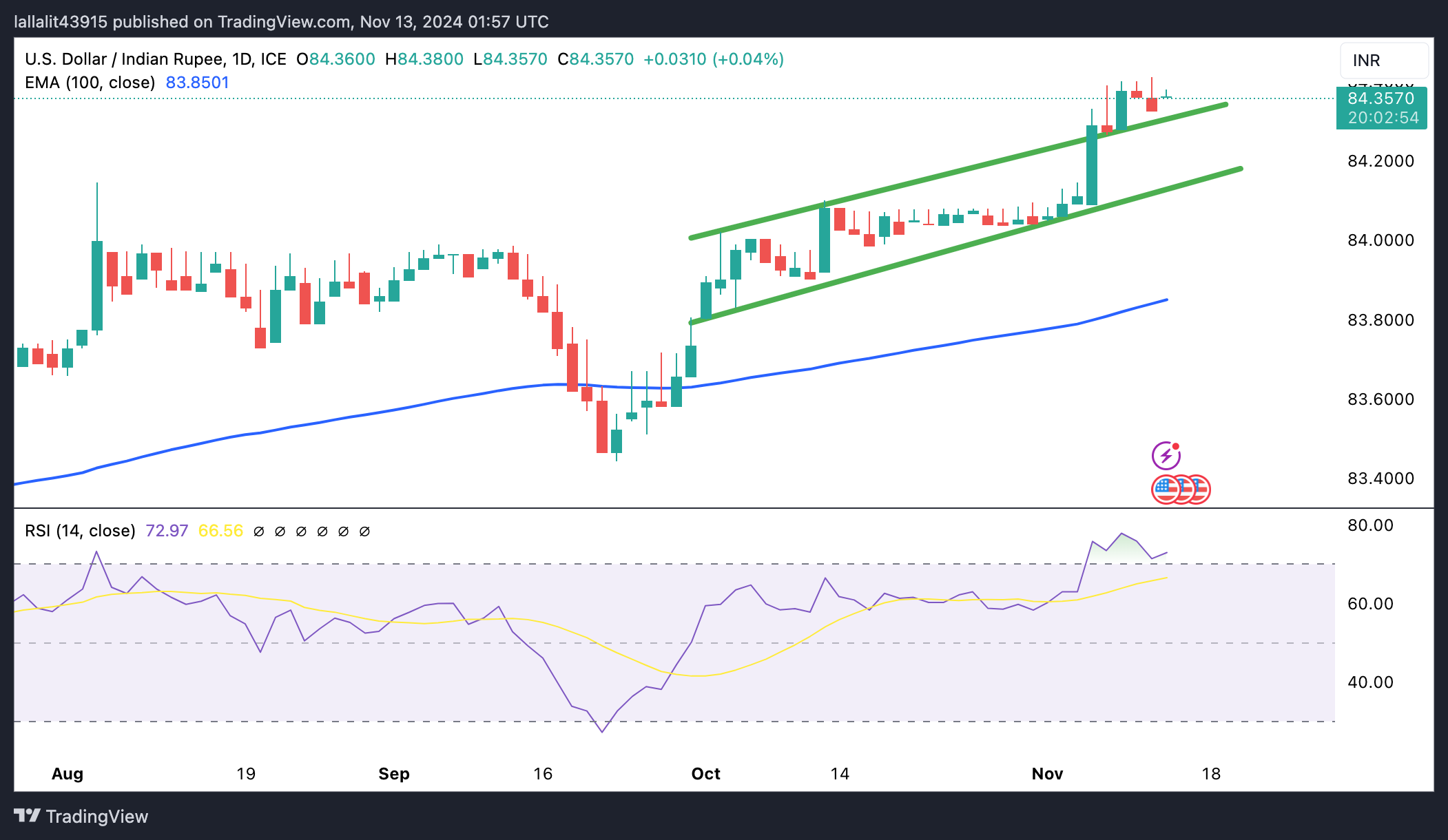USD/INR strengthens on persistent outflows, firmer US Dollar
- The Indian Rupee softens in Wednesday’s Asian session.
- Strong USD demand and considerable foreign institutional outflows weigh on the INR.
- Traders await the US October CPI inflation data on Wednesday for fresh impetus.
The Indian Rupee (INR) trades in negative territory on Wednesday after reaching a fresh all-time low in the previous session. The local currency is under pressure due to substantial foreign institutional outflows and heightened US Dollar (USD) demand.
Despite a strengthening Greenback and outflows from local stocks, the downside for the INR might be limited amid routine interventions from the Reserve Bank of India (RBI) to sell the USD to stabilize the currency. Later on Wednesday, traders will closely monitor the US October Consumer Price Index (CPI), along with the speeches from John Williams, Lorie Logan, Jeffrey Schmid and Alberto Musalem.
Indian Rupee seems vulnerable ahead of key US CPI inflation data
- India's retail inflation, based on the Consumer Price Index (CPI), rose to a 14-month high at 6.21% YoY in October versus 5.49% prior, higher than the 5.81% expected.
- India’s food inflation jumped to 10.87% from 9.24% in September 2024 and 6.61% in October 2023, according to the latest official data released on Tuesday.
- Indian Industrial Production grew by 3.1% YoY in September from a decline of 0.1% in August. This figure came in better than the estimation of 2.5%.
- Foreign investors withdrew nearly $3 billion from local stocks in November, adding to the $11 billion of outflows in October.
- Minneapolis Fed President Neel Kashkari said on Tuesday that the Fed feels confident about its long-running battle with transitory inflation, but it’s premature to declare outright victory. Kashkari further stated that the US central bank won't model Trump policies' effect on the economy until they become clear.
- Richmond Fed President Tom Barkin noted on Tuesday that while inflation appears to be coming down, it might still get stuck above the Fed's target levels.
USD/INR’s positive outlook remains in play in the longer term
The Indian Rupee softens on the day. The constructive view of the USD/INR pair remains unchanged on the daily chart, with the price holding above the key 100-day Exponential Moving Average (EMA). However, the 14-day Relative Strength Index (RSI) exceeds 70, indicating an overbought condition. This suggests that further consolidation cannot be ruled out before positioning for any near-term USD/INR appreciation.
The immediate resistance level for USD/INR emerges at 84.50. A break above this level could draw in enough bullish pressure to the 85.00 psychological level.
In the bearish event, sustained trading below the resistance-turned-support level at 84.30 could expose the 84.05-84.10 region, representing the lower limit of the trend channel and the high of October 11. The next downside filter to watch is 83.85, the 100-day EMA.

Indian Rupee FAQs
The Indian Rupee (INR) is one of the most sensitive currencies to external factors. The price of Crude Oil (the country is highly dependent on imported Oil), the value of the US Dollar – most trade is conducted in USD – and the level of foreign investment, are all influential. Direct intervention by the Reserve Bank of India (RBI) in FX markets to keep the exchange rate stable, as well as the level of interest rates set by the RBI, are further major influencing factors on the Rupee.
The Reserve Bank of India (RBI) actively intervenes in forex markets to maintain a stable exchange rate, to help facilitate trade. In addition, the RBI tries to maintain the inflation rate at its 4% target by adjusting interest rates. Higher interest rates usually strengthen the Rupee. This is due to the role of the ‘carry trade’ in which investors borrow in countries with lower interest rates so as to place their money in countries’ offering relatively higher interest rates and profit from the difference.
Macroeconomic factors that influence the value of the Rupee include inflation, interest rates, the economic growth rate (GDP), the balance of trade, and inflows from foreign investment. A higher growth rate can lead to more overseas investment, pushing up demand for the Rupee. A less negative balance of trade will eventually lead to a stronger Rupee. Higher interest rates, especially real rates (interest rates less inflation) are also positive for the Rupee. A risk-on environment can lead to greater inflows of Foreign Direct and Indirect Investment (FDI and FII), which also benefit the Rupee.
Higher inflation, particularly, if it is comparatively higher than India’s peers, is generally negative for the currency as it reflects devaluation through oversupply. Inflation also increases the cost of exports, leading to more Rupees being sold to purchase foreign imports, which is Rupee-negative. At the same time, higher inflation usually leads to the Reserve Bank of India (RBI) raising interest rates and this can be positive for the Rupee, due to increased demand from international investors. The opposite effect is true of lower inflation.



